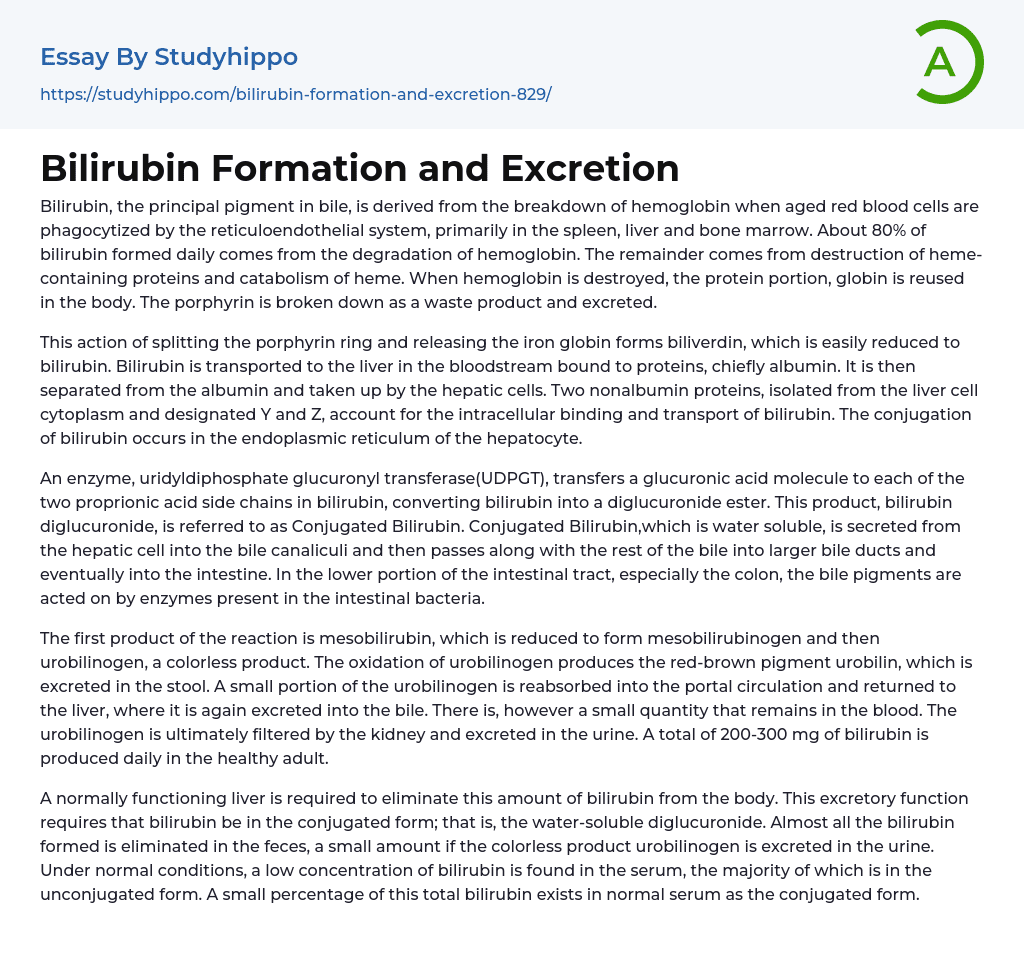Bilirubin, the principal pigment in bile, is derived from the breakdown of hemoglobin when aged red blood cells are phagocytized by the reticuloendothelial system, primarily in the spleen, liver and bone marrow. About 80% of bilirubin formed daily comes from the degradation of hemoglobin. The remainder comes from destruction of heme-containing proteins and catabolism of heme. When hemoglobin is destroyed, the protein portion, globin is reused in the body. The porphyrin is broken down as a waste product and excreted.
This action of splitting the porphyrin ring and releasing the iron globin forms biliverdin, which is easily reduced to bilirubin. Bilirubin is transported to the liver in the bloodstream bound to proteins, chiefly albumin. It is then separated from the albumin and taken up by the hepatic cells. Two nonalbumin proteins, isolated from the liver cell cytoplasm and designated Y and Z, account for th
...e intracellular binding and transport of bilirubin. The conjugation of bilirubin occurs in the endoplasmic reticulum of the hepatocyte.
An enzyme, uridyldiphosphate glucuronyl transferase(UDPGT), transfers a glucuronic acid molecule to each of the two proprionic acid side chains in bilirubin, converting bilirubin into a diglucuronide ester. This product, bilirubin diglucuronide, is referred to as Conjugated Bilirubin. Conjugated Bilirubin,which is water soluble, is secreted from the hepatic cell into the bile canaliculi and then passes along with the rest of the bile into larger bile ducts and eventually into the intestine. In the lower portion of the intestinal tract, especially the colon, the bile pigments are acted on by enzymes present in the intestinal bacteria.
The first product of the reaction is mesobilirubin, which is reduced to form mesobilirubinogen and then urobilinogen, a colorless product
The oxidation of urobilinogen produces the red-brown pigment urobilin, which is excreted in the stool. A small portion of the urobilinogen is reabsorbed into the portal circulation and returned to the liver, where it is again excreted into the bile. There is, however a small quantity that remains in the blood. The urobilinogen is ultimately filtered by the kidney and excreted in the urine. A total of 200-300 mg of bilirubin is produced daily in the healthy adult.
A normally functioning liver is required to eliminate this amount of bilirubin from the body. This excretory function requires that bilirubin be in the conjugated form; that is, the water-soluble diglucuronide. Almost all the bilirubin formed is eliminated in the feces, a small amount if the colorless product urobilinogen is excreted in the urine. Under normal conditions, a low concentration of bilirubin is found in the serum, the majority of which is in the unconjugated form. A small percentage of this total bilirubin exists in normal serum as the conjugated form.
- Microbiology essays
- Bacteria essays
- Cell essays
- Enzyme essays
- Photosynthesis essays
- Plant essays
- Natural Selection essays
- Protein essays
- Viruses essays
- Cell Membrane essays
- Human essays
- Stem Cell essays
- Breeding essays
- Biotechnology essays
- Cystic Fibrosis essays
- Tree essays
- Seed essays
- Coronavirus essays
- Zika Virus essays
- Agriculture essays
- Albert einstein essays
- Animals essays
- Archaeology essays
- Bear essays
- Biology essays
- Birds essays
- Butterfly essays
- Cat essays
- Charles Darwin essays
- Chemistry essays
- Dinosaur essays
- Discovery essays
- Dolphin essays
- Elephant essays
- Eli Whitney essays
- Environmental Science essays
- Evolution essays
- Fish essays
- Genetics essays
- Horse essays
- Human Evolution essays
- Isaac Newton essays
- Journal essays
- Linguistics essays
- Lion essays
- Logic essays
- Mars essays
- Methodology essays
- Mineralogy essays
- Monkey essays




